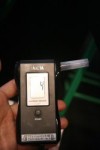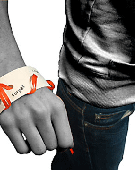Oct 12, 2007
Stop smoking programs go mobile
Via Textually.org [via Reuters]
Colorado's STEPP and Denver-based ad agency Cactus developed a message system on cell phones with an Internet quit program.
Initially aimed at high school students in Colorado, the state hopes to soon share its fledgling FixNixer program as a technique for all age groups and geographies.
QuitNet.com, one of the most established Web sites for quitting, is also considering more tailored messages to users of its site and a foray into mobile, while quit support groups are popping up on social networks MySpace and Facebook.
18:08 Posted in Persuasive technology | Permalink | Comments (0) | Tags: persuasive technology
Jul 26, 2007
Mobile Persuasion: the book
A good reading on mobile persuasion - Edited by BJ Fogg and Dean Eckles

For more info, see www.mobilepersuasion.com

19:40 Posted in Persuasive technology | Permalink | Comments (0) | Tags: persuasive technology
Apr 27, 2007
Using Eyetracking to Optimise Persuasion-Centered Design
From UsabilityNews
Event Date: 26 April 2007 to 26 April 2007
Using Eyetracking to Optimise Persuasion-Centered Design: Rob Stevens, Bunnyfoot
Persuasion-Centered Design (PCD) utilises behavioural segmentation to plan different user journeys for different personality types. For example, competitive consumers receive less detailed information than methodical consumers. PCD facilitates consumers in self-selecting their behavioural type by utilizing descriptive in line links. By eyetracking consumers we can see if they engage with a link and choose not to select it. With PCD this outcome is often a planned for event, one that would be impossible to reliably measure without eyetracking.
12:40 Posted in Persuasive technology | Permalink | Comments (0) | Tags: eye-tracking, persuasive technology
Feb 17, 2007
NTT DoCoMo breathalyzer phone
Via Medgadget

The NTT DoCoMo breathalyzer phone sends a text message to your boss before you get behind the wheel of your company's bus or truck.
Gizmodo report:
KDDI Corp has developed a breathalyzer/cellphone combo that prevents inebriated taxi and bus drivers in Japan from getting behind the wheel. Companies that buy the phone will require their employees to blow into the breathalyzer before getting behind the wheel. The phone then measures how drunk (or sober) you are and sends the results to your company's computer along with a snapshot of the your mug and your location. If you've had too much sake, the phone will notify your boss who'll most likely fire your drunk ass. The phone and software cost a combined $1,250, which shouldn't be too much money for a big company to spend.
20:36 Posted in Persuasive technology | Permalink | Comments (0) | Tags: persuasive technology
Dec 15, 2006
Intelligent rooms: RoomRender
Via Pink Tentacle

SGI Japan has developed a system that can control the electronics, appliances and hardware in a room based on the spoken commands and emotions of the room’s occupants. RoomRender relies on AmiVoice voice recognition technology (developed by Advanced Media) to recognize and analyze spoken commands, enabling the room to close the blinds, turn on the heater, etc. as instructed.
Read the full story on Pink Tentacle
00:11 Posted in Pervasive computing | Permalink | Comments (0) | Tags: ambient intelligence, emotional computing, pervasive technology, persuasive technology
Dec 03, 2006
PERSUASIVE 07
From usability news
You are invited to submit papers for PERSUASIVE 07 at Stanford University, April 27-28, 2007.
We welcome original papers based on empirical studies, theory, methods for research, and related ethical issues; and case studies of the highest quality.
Link to the conference website
14:30 Posted in Persuasive technology | Permalink | Comments (0) | Tags: persuasive technology
Oct 06, 2006
DietMate Weight Loss Computer
Via Mindware Forum
DietMate is a hand-held computer that provides a program of weight loss, cholesterol reduction, and hypertension control. DietMate is made by Personal Improvement Computer Systems (PICS), which also makes two other tiny computerized mindgadgets: SleepKey Insomnia Treatment Hand-held Computer and the QuitKey Smoking Cessation Hand-Held Computer.
From the PICS website:
DietMate provides a sophisticated, yet easy to use, nutrition and exercise program that is tailored to each user's nutritional requirements, food preferences, and habits. By providing hundreds of nutritionally balanced menus which can be customized as desired, DietMate picks up where calorie counters leave off.
DietMate also tracks calories, fat, saturated fat, cholesterol and sodium. It provides daily nutritional targets, charts progress and even creates a shopping list. DietMate has been proven effective in both weight and cholesterol reduction, in clinical studies funded by the National Heart Lung and Blood Institute.
10:05 Posted in Cybertherapy, Persuasive technology | Permalink | Comments (0) | Tags: persuasive technology, cybertherapy, hand-held computer
Sep 30, 2006
Perimeters, Boundaries, and Borders
|
Artists, architects, designers, and other practitioners are constantly fashioning new forms and challenging disciplinary boundaries as they employ techniques such as rapid prototyping and generative processes. In the exhibition Perimeters, Boundaries, and Borders, at Lancaster, UK's Citylab, organizers Fast-uk and Folly explore the range of objects, buildings, and products being conceptualized with the aid of digital technologies. Aoife Ludlow's 'Remember to Forget?' is a series of jewelry designs that envisioned accessories incorporating RFID tags that allow the wearer to record information and emotions associated with those special items that we put on daily. Tavs Jorgensen uses a data glove in his 'Motion in Form' project. After gesturing around an object, data collected by the glove is given physical shape using CNC (Computer Numerical Control) milling, creating representations of the movements in materials such as glass or ceramics. Addressing traces of a different sort is Cylcone.soc, a data mapping piece by Gavin Bailey and Tom Corby. These works and many more examples from the frontiers of art and design are on view until October 21st." Rhizome News. |
19:39 Posted in Emotional computing, Pervasive computing | Permalink | Comments (0) | Tags: ambient intelligence, emotional computing, pervasive technology, persuasive technology
Sep 18, 2006
QuitKey Smoking Cessation Computer
Via Mindware
QuitKey is a small portable device that promises to help quit smoking:
This small device, which resembles an automobile keyless remote containing a computer that collects data on the test subject's smoking habits for one week. The computer implements a gradual rate reduction protocol targeting both the physiological dependence on nicotine and conditioned stimuli that may trigger the urge to smoke. QuitKey� cues the individual when it is time for him or her to smoke, based on their history. In reality, what it is trying to do is take away the natural instinct to smoke on impulse, instead teaching the women to smoke on a gradually diminishing schedule.
The device was recently tested in a small-scale pilot clinical study by tobacco-addiction researcher Monica Scheibmeir.
For the study, 10 participants were given a QuitKey, which was attached to a cigarette lighter. Every time the participant reached for the lighter, she was prompted to input data into the QuitKey. According to Scheibmeir, early results are promising.
20:40 Posted in Persuasive technology, Wearable & mobile | Permalink | Comments (0) | Tags: persuasive technology, cybertherapy
Jul 24, 2006
Mobile Persuasion 06
BJ Fogg's Persuasive Technology Lab (Stanford University) is sponsoring Mobile Persuasion 06, a one-day conference on how mobile technology can change people's beliefs and behaviors.

From the conference website:
Mobile Persuasion is for innovators, researchers, and companies creating mobile technologies that change people’s beliefs and behaviors. Applications include health, commerce, activism, social networking, addiction, advertising, gaming, and environmental conservation. This full-day event will feature expert presentations and panels on how mobile technology can change attitudes and behaviors.
The event will take place November 10th at Stanford University. Free registration is available for a limited time.
21:45 Posted in Persuasive technology, Wearable & mobile | Permalink | Comments (0) | Tags: persuasive technology
Jul 03, 2006
Ethics of Persuasive Technology
BJ Fogg has posted to his blog "Captology Notebook" an unpublished article on the ethics of persuasive technology that is really worth reading...
ANALYZING THE ETHICS OF PERSUASIVE TECHNOLOGY
2005
DANIEL BERDICHEVSKY
B.J. FOGG
RAMIT SETHI
MANU KUMAR
Stanford Persuasive Technology Lab
Authors' addresses: Daniel Berdichevsky, 1006 Wall St. Los Angeles, CA 90015; B.J. Fogg, Ramit Sethi and Manu Kumar, Persuasive Technology Lab, Stanford University, Box 20456, Stanford, CA 94309
________________________________________________________________________
1. INTRODUCTION
When a doctor tells you your blood pressure is too high, you may modify your lifestyle to compensate: less salt, more exercise, fewer freedom fries. In a sense, the doctor has committed a persuasive act. We are unlikely to question the ethics of her having done so. But what if the doctor were out of the picture? Suppose a device at your bedside not only informed you of your blood pressure each morning, but shifted colors to convey the likelihood of your suffering a heart attack. Would such a persuasive technology be as ethical as a doctor giving you advice in her office? What if it were co-marketed with a treadmill?
The objective of this article is to describe and test a framework for analyzing the ethics of technologies that change people’s attitudes and behaviors. We focus on computerized persuasive technologies—the field known as “captology”—though similar considerations apply to non-computerized technologies, and even to technologies that change attitudes and behaviors by accident.
This idea of unintended persuasive outcomes is one reason we are revisiting this topic four years after the publication of an earlier piece by one of the authors, “Toward an Ethics of Persuasive Technology.” [Berdichevsky & Neuenschwander, 1999] Since 1999, persuasive elements have become common enough in both hardware and software—and especially on the web—that designers may not always be conscious of their persuasive nature. They may take them for granted. This telephone beeps to remind you to check your voice mail; that search engine changes its logo every day in a continuing narrative to pull you back more often . But even when persuasion is incidental to other design motives, it requires ethical attention—particularly because end users may not be expecting it and are therefore caught with their defenses down. [Fogg, 2002]
Why pay special attention to computerized persuasive technologies? The chief reason is that while non-computerized technologies can certainly be persuasive, only rarely can they stand on their own . A television with no infomercial to display will not convince you to buy new cutlery. A whip without someone to wield it will cow no slave into obedience. Even a carpool lane requires enforcement.
What makes computerized persuasive technologies more interesting than these examples is that they can persuade independently. Computerized persuasive technologies are also dynamic, changing in response to different users and their inputs. They allow persuasion—and the persuasive experience—to be simultaneously mass-manufactured and user-specific. For instance, a wristwatch that encourages you to keep running by congratulating you on the specific number of calories you have burned is completely self-contained. This leads to questions of agency: do you blame the wristwatch if a runner suffers a heart attack trying to achieve a certain pulse?
The full article can be accessed here
23:25 Posted in Persuasive technology | Permalink | Comments (0) | Tags: persuasive technology
Jun 01, 2006
Ringxiety
Re-blogged from Smart Mobs
Following the New York Times story on "audio illusion, phantom phone rings or ringxiety and fauxcellarm" - described as the new reason for people to either bemoan the techno-saturation of modern life or question their sanity, News.com.au via Engadget now claims the phenomenon - of falsely believing you hear your mobile phone ringing or vibrating - is so widespread it has an official name: "ringxiety" and it's really the subconscious calculating how popular we are.
David Laramie, from California's School of Professional Psychology, who coined the termed ringxiety and says he himself is a sufferer.
More on phanthom vibrations and phanthom rings in Ringtonia.
19:06 Posted in Persuasive technology | Permalink | Comments (0) | Tags: persuasive technology









